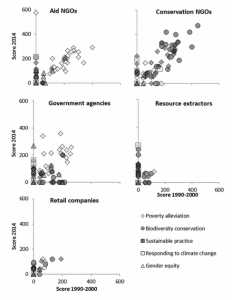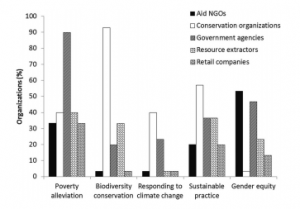Portrayal of sustainability principles in the mission statements and on home pages of the world’s largest organizations
By Dana Tricarico, SRC Intern
The 1992 United Nations Conference on Environment and Development held in Rio de Janeiro showed a wide span global agreement to change attitudes and behavior regarding sustainable development- an increasingly important idea beginning in the 1970’s. Conventions and commissions such as these led to terms like “corporate social responsibility (CSR),” i.e. the concept that companies should take into account not only economic objectives, but also social and environmental objectives. By 2010, all Fortune 500 companies reported on CSR. However, despite the CSR efforts and the growing awareness of sustainable practices, there has been some concern that certain organizations may omit or exaggerate their sustainable practices.
Due to this uncertainty, researchers at Charles Darwin University and the Nature Conservancy in Brisbane Australia conducted a study to see whether the increase in knowledge of concepts related to sustainability have actually increased the extent to which companies promote these concepts. In order to do so, two communication tools were looked at for various organizational types. The first communication tool was company mission statement, showing the core values of organizations. The second communication tool was Internet home pages, which are crucial modern forms of marketing for large companies that represent the goals of that company. More specifically, these researchers compared the wording of their oldest mission statement before 2000 to their newest form in 2014 for 150 organizations. Non-governmental organizations (NGOs), aid NGOs, government development agencies, resource extraction companies, and retailers were all represented in this study. Each statement was analyzed based on their aspirations of poverty alleviation, biodiversity conservation, sustainable practice, climate-change reduction, and gender equity.

Mission statement scores for each of five aspirations compared between the early mission statement (before 2000) and the recent mission statement observed in 2014. A score of zero means that there was no mention of the aspiration. In contrast, a score of 600 means that that aspiration was the top element in the mission statement. Each group consists of 30 large organizations.
After comparing the mission statements for each company, the research team found that organizations differed significantly in the importance of each aspiration. There was a shift towards sustainable ideals in mission statements for some of the five industry sectors, most notably seen in the resource extraction companies. The comparison of the 2014 web home pages showed that conservation NGOs favored wildlife in their aspirations as an organization, and aid NGOs focused more on poor communities and the empowerment of women. It also seemed as though mining companies were proud of their environmental record based on the fact that many of their websites portrayed the need for an increased awareness in sustainable concepts.

The percentage of company home web pages depicting an awareness for poverty alleviation, biodiversity conservation, sustainable practice, responding to climate change and gender equity. Each group consists of 30 large organizations.
However, despite some positive changes between mission statements and home pages, there were many issues associated with the findings. The first issue is that there was little change over time despite the large increase in sustainability knowledge since the 1970’s. Another issue proved that while many companies value sustainable ideals, there was little mention as to how they planned to achieve those ideals, especially when it came to climate change.
The conclusions from this research are useful because it shows that these companies need to measure their commitment to sustainability principles in a different form than the CSR reports in order to better hold themselves accountable to their ideals. Additionally, the results show that there still needs to be a greater emphasis on sustainability principles in the core values of major companies. Due to the influence of large companies, this shift could help influence stakeholders and the general public to change their sustainability practices in the future.
Outside Source Used:
Garnett, S. T., Lawes, M. J., James, R., Bigland, K., & Zander, K. K. (2015). Portrayal of sustainability principles in the mission statements and on home pages of the world’s largest organizations. Conservation Biology.




Leave a Reply
Want to join the discussion?Feel free to contribute!